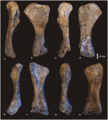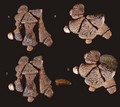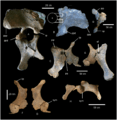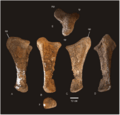Diamantinasaurus facts for kids
Quick facts for kids Diamantinasaurus |
|
|---|---|
 |
|
| Scientific classification | |
| Kingdom: | |
| Phylum: | |
| Class: | |
| Superorder: | |
| Order: | |
| Suborder: | |
| Infraorder: | |
| (unranked): | |
| Genus: |
Diamantinasaurus
Hocknull et al., 2009
|
| Species | |
|
|
Diamantinasaurus is a type of dinosaur called a titanosaur. It lived in Australia during the Cretaceous Period, about 100 million years ago. This dinosaur was a large plant-eater.
Contents
Discovering Diamantinasaurus
Scientists found the first bones of Diamantinasaurus in Winton, Queensland, Australia. This happened over several years of digging. They found these bones next to other fossils. These included bones from another dinosaur called Australovenator, and also crocodylomorphs and molluscs.
In 2009, a scientist named Scott Hocknull and his team described these new dinosaurs. The bones from one of the dinosaurs, called AODF 603, became the main example for Diamantinasaurus. This specific dinosaur was named D. matildae.
The name Diamantinasaurus comes from the Diamantina River. This river flows near where the bones were found. The word sauros means "lizard" in Greek. The species name matildae is a nod to the famous Australian song "Waltzing Matilda." This song was written in Winton.
The main bones found for Diamantinasaurus included parts of its shoulder, arm bones, ribs, and hip. They also found parts of its leg. All these bones came from a place called the "Matilda Site." This site is about 60 miles (97 km) west of Winton. The rocks there are from the Late Cretaceous period.
The discovery of Diamantinasaurus was very exciting for Australia. It was the first new sauropod dinosaur named there in over 75 years. Diamantinasaurus was nicknamed "Matilda." The other dinosaur found with it, Australovenator, was called "Banjo." Another dinosaur from the same area, Wintonotitan, was nicknamed "Clancy." This discovery was one of the biggest dinosaur finds in Australia since 1981.
Later, in 2016, more Diamantinasaurus bones were found. These included parts of its skull and braincase. They also found more neck and back bones, and another shoulder blade.
What Diamantinasaurus Looked Like
Diamantinasaurus was a large dinosaur, but it was fairly small for a titanosaur. It probably grew to be about 49 to 52 feet (15 to 16 meters) long. It might have weighed between 15 and 20 tons. That's like the weight of several large elephants!
Some of its relatives had bony armor plates on their skin. We don't know if Diamantinasaurus had these. Like all other sauropods, Diamantinasaurus was a quadrupedal herbivore. This means it walked on all four legs and ate only plants.
How Diamantinasaurus Grew
In 2011, scientists found the smallest known titanosaur embryo. An embryo is a very early stage of a baby animal. This tiny fossil was found in Mongolia. It looked very similar to Diamantinasaurus and another dinosaur called Rapetosaurus.
The embryo was inside a round egg, about 3.5 inches (9 cm) across. This egg was part of a whole nesting site. This means many titanosaur eggs were laid there. Scientists believe these eggs were laid during the Early Cretaceous period. This discovery helps us learn how these giant dinosaurs grew from tiny embryos.
Images for kids
-
Reconstructed skeleton of closely related Savannasaurus
See also
 In Spanish: Diamantinasaurus matildae para niños
In Spanish: Diamantinasaurus matildae para niños











